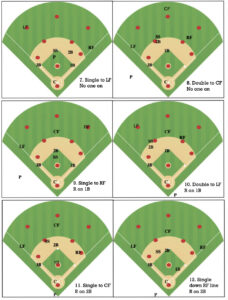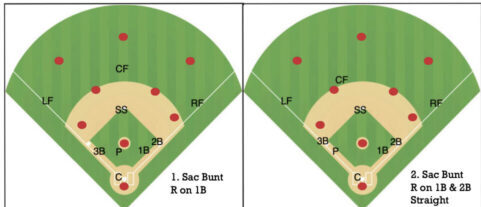If you watch a lot of amateur baseball, you’ll see overall quite a bit of lack of knowledge on positioning and how to efficiently perform cuts and relays. This is seen in a college a bit too, particularly in younger players who haven’t had the training growing up.
In order to get players on the same page and best play winning baseball, it is imperative all players are coached on these elements, and have a split-second awareness of how to perform these correctly.
Here are some positioning techniques, that while some people may teach differently, if you think about it, make a lot of sense:
Passed Ball – Runner on 3B
A lot of people yell at the 1B to back up, which is fine, but it really should be the shortstop. He has no other responsibilities, and since most times when the catcher throws it past the pitcher, it goes towards the mound, he has a direct angle to easily collect the stray throws.
Double Play Depth – RHH
Most times double play depth is taught to move two-in and two-over. However, this causes routine ground balls towards the hole that the infielder would normally get to end up going-through, or simply get one out. The goal is to get closer to the batter due to extra time needed to turn two, as well as get closer to the bag in case the SS is needed to cover. By determing where the odds are the hitter will hit it, then moving halfway in towards the hitter, this achieves both, and in turn greatly increases double plays turned.
Single to LF – No one on
Everybody has the shortstop go out and be cut-off man, and the 2B covers second. If you think about this, it’s kind of ridiculous. If there needs to be a play on the batter at second base on a single, he will be safe if there is a cut-off. The only way to get him would be a direct throw. Thus, why not have this be the base play – throw directly to second? This not only helps train the outfielder on this throw, but it also allows their to be a proper backup system where the shortstop covers second, and the 2B backs up the play.

Double to right Field – No one on
When there is a double, the tandem-relay is used (shortstop as lead cut and 2B right behind). Sometimes this is abandonded when the ball is down the right-field line and the 2B ends up being the lead cut in front of the shortstop. While this might seem intuitive, this is a bad idea generally for two reasons: the 2B most often has a weaker arm, and thus is unable to execute the long throw to third very well; Also, by having the shortstop as the lead cut all-the-time, there is never any confusion. Finally, it is really only about a 100-foot run for the shortstop, so the concern about the SS getting there in time is largely unfounded.



